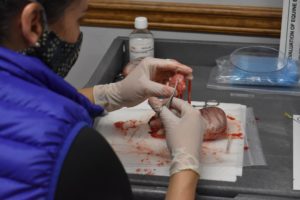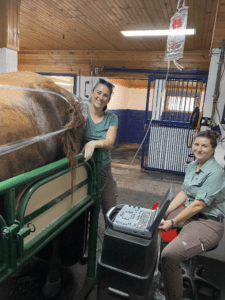#AskTheVet with Dr. Jenn Linton
Question: Is there a way to increase my mare’s chances of getting pregnant?
Answer: When thinking about increasing chances of pregnancy, we have to think about both the stallion (semen) and mare sides of things. The stallion side is fairly straightforward: more motile sperm = better pregnancy rate. Pregnancy rates decrease as we do more with the sperm, so the highest pregnancy rates are with well-timed live cover breedings, followed by cooled shipped semen, and then frozen semen. There are obviously variations between stallions and management – I’ve seen very poor quality shipped semen and excellent frozen semen, but broadly that’s the progression. There are ways to increase the efficacy of your breeding within the same type of semen, say switching from post-ovulation insemination with a single dose of frozen semen to timed insemination with two doses of frozen semen, and we always try to set up your mare for breeding to ensure ideal timing of insemination.
cover breedings, followed by cooled shipped semen, and then frozen semen. There are obviously variations between stallions and management – I’ve seen very poor quality shipped semen and excellent frozen semen, but broadly that’s the progression. There are ways to increase the efficacy of your breeding within the same type of semen, say switching from post-ovulation insemination with a single dose of frozen semen to timed insemination with two doses of frozen semen, and we always try to set up your mare for breeding to ensure ideal timing of insemination.
When picking a stallion, always ask what type of semen is available (fresh or frozen) and what the pregnancy rates are per breeding.
On the mare side, things get a bit more complicated, so let’s start with the basics. The younger the mare, the easier it generally is to get her pregnant (once she’s gone through puberty). If your mare is too fat or too thin, it will be difficult to get her pregnant. If your mare has a concurrent disease, most commonly PPID (pituitary pars intermedia dysfunction/Cushings), that is not well regulated, we will most likely have issues. If you have a young (3-10 years old), healthy mare and are breeding with cooled, shipped semen, you are off to a good start.
dysfunction/Cushings), that is not well regulated, we will most likely have issues. If you have a young (3-10 years old), healthy mare and are breeding with cooled, shipped semen, you are off to a good start.
Now, if your mare has previously had a foal or been bred, we’ll need to make sure she doesn’t have any issues by performing a breeding soundness examination. This includes a transrectal palpation and ultrasound, and may include a traditional uterine culture and cytology, low-volume uterine lavage, manual vaginal exam, and uterine biopsy depending on your mare’s history and our findings. Each of these data will help us to make an optimal plan for breeding your mare. We may have to treat her uterus with antibiotics prior to breeding, or lavage her uterus to help with uterine clearance after breeding. The culture may identify a biofilm that needs to be treated with a combination of antibiotics and lavages, or the biopsy may indicate that your mare would be best as an embryo donor as her uterus will not be able to adequately nourish an embryo.
be treated with a combination of antibiotics and lavages, or the biopsy may indicate that your mare would be best as an embryo donor as her uterus will not be able to adequately nourish an embryo.
The summary is that there is not one fool-proof way to increase your mare’s chances of getting pregnant. Find a stallion with reputable semen and a veterinarian who knows what she/he/they is doing, and don’t wait until your mare is 26 years old with PPID.
Recent Posts
About Us
At B.W. Furlong & Associates, we are progressive leaders delivering the ultimate in veterinary care to our equine patients and clients in both the hospital and ambulatory setting. We have several associated practices offering exemplary care and services in New Jersey, Florida, and Virginia
